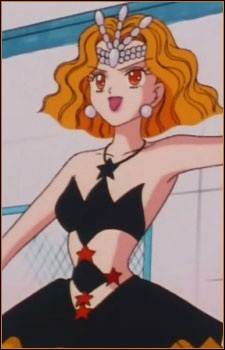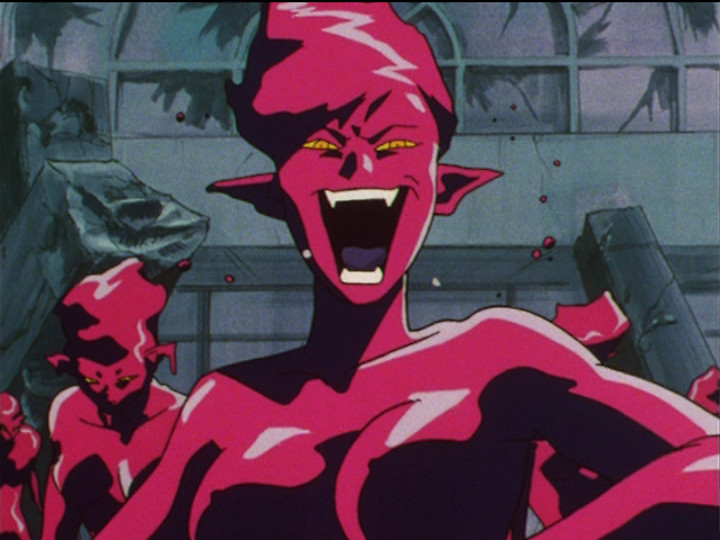Finishing up our series on the puns, wordplays, and other linguistic background to the names of the Sailor Moon S Daimons, today we’re looking at those who worked under Mimete. If you haven’t had a chance to yet, you can first read up on Part 1 and Part 2 here!
Ah, Mimete. Interestingly enough, in the manga at least, she was the most popular of the Witches 5.1 If you don’t count Mistress 9 as a Death Buster – which I wouldn’t, personally, since she answered straight to Pharaoh 90 and went over Prof. Tomoe’s head – that makes her the most popular of all the Death Busters!
I guess this might be related to how fans found it in their hearts to forgive Mimete for, you know, brutally murdering her co-worker.
Anyway, back to the point at hand – Daimons! With Mimete, a new theme was added in: all their names begin with う (u), which comes from the Japanese word 鵜飼い (ukai; cormorant fishing).2
Mimete was inspired by the Japanese/Chinese practice of training cormorant birds to gulp up fish. The fishermen tie snares around the birds’ necks which prevents them from swallowing the fish, letting the fishermen pull them out later.
Her plan was to have the Daimon suck up the pure hearts for her to retrieve at her leisure. Pretty interesting, huh?
Well, let’s see what other secrets their names may be hiding!
- U-Estern: A clever play on the Japanese pronunciation of the word “western,” pretty clearly in reference to the Western (i.e., cowboy) genre of movies.
- U-Henshuu: Coming from the word to edit (編集; henshuu),3 she’s pretty clearly inspired by that of an editor – specifically, a manga editor.4 Interestingly enough, she also has demon horns on her head. Makes you kind of wonder what the animators were trying to say about editors…
- U-Tahimee: A play off of the Japanese word 歌姫 (utahime),5 meaning a songstress or diva. The fact that she often forgets lyrics is apparently not too important to her being a successful singer…
- U-Tomodachi: Taken from 友達 (tomodachi),6 the word for friend. Not much to see here. Next!
- U-Baara: One look at the design would probably explain this, but the name comes from the Japanese word for rose, bara (バラ).7
- U-Ndookai: Her name is a derivation on the word used for Japanese school sports festivals, undoukai (運動会).8
- U-Ikasaman: For once, we have a less common Japanese word! Still a Japanese word in the dictionary, but at least it’s less straight-forward. Ikasama (如何様) is a word that means “fraud” or “swindler.”9
- U-Chouten: Once again, more Japanese word play! This time, coming from 有頂天 (uchouten)10 the word for “ecstasy,” or to be “beside oneself with joy.”
- U-Pasokon: Cases like this are always interesting to me, because the name comes from パソコン (pasokon)11 a Japanese abbreviation for an English word, in this case “personal computer.” While pasokon is certainly… accurate, I would almost feel like U-Persocom, or U-PC would be nicer.
Bonus Round!
Since there are just a few Daimons left, I figured I’d address those here. If you’re looking for Germatoid, note that I already covered that with the Death Busters.
- Rangey: Was born of a microwave, which is called denshi renji (電子レンジ; lit. electric range),12 in contrast with a traditional range – also known as that big thing in your house that has burners and an oven.
- Narisokonai: Finally! A Daimon with an interesting name! While you often will see these red, gelatinous, generic Daimon referred to as unnamed, in the materials they’ve been given the name Narisokonai,13 a word that means to fail in the midst of a transformation, or attempt to become something else. Basically, a failed Daimon. To be fair, this could be a description and not a name, but this is from a kid’s book and by no means a normal Japanese phrase, so I have a hard time believing it.
And there you have it, all of the names of the Daimons explored, explained, and… expounded upon.
Unfortunately, the name choices for Mimete were a little lackluster, but it still winds up being interesting for me to stop down, take a look, and actually think about what these names mean and how it ties into the character designs.
Can’t wait to stop down and take up another look at monster names. I guess it’ll be Sailor Moon SuperS, then!
References:
- See the Third Nakayoshi Popularity Poll ↩
- See 鵜飼 (Jisho.org) ↩
- See 編集 (Jisho.org) ↩
- See the Nakayoshi Media Book ↩
- See 歌姫 (Jisho.org) ↩
- See 友達 (Jisho.org) ↩
- See バラ (Jisho.org) ↩
- See 運動会 (Jisho.org) ↩
- See 如何様 (Jisho.org) ↩
- See 有頂天 (Jisho.org) ↩
- See パソコン (Jisho.org) ↩
- See 電子レンジ (Jisho.org) ↩
- See the Nakayoshi Media Book ↩




Certainly an interesting prospect.
Mimete- she didn’t shock me with her popularity, she was my fave, tbh.
Could you do one on finding out who is ‘best friends’ with who in the inner senshi? For example; Minako and Makoto, and reasons stating why you think so.
Please keep posting! Love your blog!!
-LiteNing
I’ve been loving the articles on the Daimon. Has there ever been an official statement on U-Henshuu having the same color scheme as the famous alien babe Lum Invader? That particular episode also had references to Candy Candy.
People usually miss this, but U-Baara’s name is actually written in Roman letters within the actual episode as “U-Baulla”. It’s always fun to see how the animators will write names, especially when they use unconventional spellings. My favorite example is “Youzeiru” on Eudial’s locker in episode 114.
Also, according to Kodansha’s Sailor Moon Himitsu 100 Book, there are three different “types” of Daimon.
Infiltration Type – Kaolinite
Guard Type – Eudial
U Type – Mimete
Not sure why Eudial’s are “guard” types…
Oh, interesting! I didn’t hear about that!
Wonder what they meant by that, though…
Eudial’s daimones are “guard types” because they’re her bodyguards most of the time since Eudial herself hunts the pure hearts, releasing her daimon when the Sailor Soldiers show up. Kaolinite and Mimete’s daimones do the pure heart hunting for their mistresses instead.